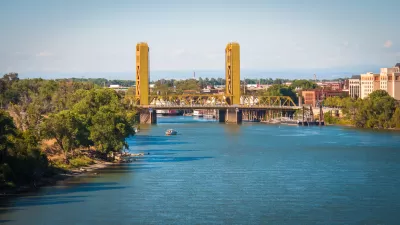The two-thirds threshold proved to be no obstacle for Sacramento streetcar proponents in a special election held June 21, when at least *250 businesses owners voted to tax themselves to fund operations of the proposed streetcar.

[Updated June 26, 2017] The Downtown/Riverfront Streetcar Project, which includes West Sacramento on the west wide of the Sacramento River in Yolo County, took a major step forward when "[n]early 80 percent of major central [Sacramento] city businesses have agreed to tax themselves a combined $50 million over the next 25 years to help cover the system’s operating costs," report Ryan Lillis and Tony Bizjak for the City Beat section of the The Sacramento Bee.
With that approval, city officials and streetcar advocates are expected to seek a full-funding grant agreement [FFGA] with the Federal Transit Administration [FTA] later this summer or fall. Local and state agencies are putting up $100 million for the project and advocates are hoping for a $100 million match from the federal government.
“Our streetcar project is on track to bring new mobility options to downtown, midtown and West Sacramento,” Sacramento Councilman Steve Hansen wrote in an email. “I’m thankful to the area’s property owners for their financial commitment to transit. Onward!”
Businesses that voted on the tax included the Sacramento Kings, Macy’s and downtown hotels. The Kings likely will pay the most into the fund, with an estimated annual contribution of about $125,000. The team has voiced its support for the project.
A major issue of uncertainty is whether the FTA's Capital Investment Grants Program will be funding projects that don't already have a signed FFGA. This uncertainty emerged first with the deferral of a $647 million Caltrain electrification grant in February until President Trump unveiled his fiscal year 2018 budget. The budget, released last month, eliminated funding for all transit projects lacking a signed FFGA.
Hat tip to L.A. Transportation Headlines.
[The article was updated to reflect the correct number of business owners supporting the new tax.]
FULL STORY: A streetcar tax just passed in Sacramento

Maui's Vacation Rental Debate Turns Ugly
Verbal attacks, misinformation campaigns and fistfights plague a high-stakes debate to convert thousands of vacation rentals into long-term housing.

Planetizen Federal Action Tracker
A weekly monitor of how Trump’s orders and actions are impacting planners and planning in America.

Chicago’s Ghost Rails
Just beneath the surface of the modern city lie the remnants of its expansive early 20th-century streetcar system.

Bend, Oregon Zoning Reforms Prioritize Small-Scale Housing
The city altered its zoning code to allow multi-family housing and eliminated parking mandates citywide.

Amtrak Cutting Jobs, Funding to High-Speed Rail
The agency plans to cut 10 percent of its workforce and has confirmed it will not fund new high-speed rail projects.

LA Denies Basic Services to Unhoused Residents
The city has repeatedly failed to respond to requests for trash pickup at encampment sites, and eliminated a program that provided mobile showers and toilets.
Urban Design for Planners 1: Software Tools
This six-course series explores essential urban design concepts using open source software and equips planners with the tools they need to participate fully in the urban design process.
Planning for Universal Design
Learn the tools for implementing Universal Design in planning regulations.
planning NEXT
Appalachian Highlands Housing Partners
Mpact (founded as Rail~Volution)
City of Camden Redevelopment Agency
City of Astoria
City of Portland
City of Laramie




























